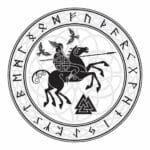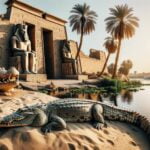Let’s dive into the fascinating world of Norse mythology and uncover the symbols tied to the enigmatic god Odin. From his trusty ravens to his dependable spear and loyal wolves, every symbol holds a special meaning, like pieces of a puzzle that reveal a grand story. We’ll explore how these symbols represent Odin’s wisdom, strength, and enduring spirit, bringing Norse mythology to life with every step. So, grab a cup of your favorite brew, get cozy, and let’s unlock the mysteries surrounding Odin’s god symbols.
Odin’s Majestic Symbols: Unveiling the Revered Norse God
In the heart of ancient Norse mythology, Odin stands tall as a captivating deity with a rich tapestry of symbols that weave together his extraordinary powers and divine nature.
At the core of Odin’s symbolism lies the enigmatic Valknut. This intricate knot, fashioned with three interlocking triangles, holds deep significance. It whispers tales of Odin’s mastery over life and death, where departed warriors are guided by this sacred symbol to Valhalla, the ethereal realm of the gods.
Beyond the Valknut, Odin’s trusty spear, Gungnir, embodies his indomitable spirit and unwavering authority. Forged with the same masterful craftsmanship that shaped Thor’s legendary hammer, Mjolnir, Gungnir is a testament to Odin’s formidable power and unyielding presence.
Soaring through the vast expanse, Odin’s faithful ravens, Huginn and Muninn, serve as his keen-eyed messengers. Their restless flights across the realms gather knowledge and wisdom that quench Odin’s insatiable thirst for enlightenment.
Flanking Odin’s side are his loyal companions, the wolves Geri and Freki. Their fierce presence mirrors Odin’s unwavering loyalty and unwavering protection. They are his constant guardians, symbolizing the formidable nature of the god they serve.
Finally, the Triple Horn, adorned with Odin’s image, holds a sacred significance. It represents the mythical Mead of Poetry and Wisdom, an elixir with the power to bestow inspiration and knowledge upon those who sip its magical nectar. This potent symbol speaks to Odin’s deep connection to the realms of art and intellect.
Each of these symbols paints a vibrant portrait of Odin, revealing the multifaceted nature of this enigmatic god. From his mastery over life and death to his relentless pursuit of wisdom and the unwavering loyalty of his companions, Odin’s symbols stand as a testament to his enduring legacy in the rich tapestry of Norse mythology.
Discover the rich history and fascinating meanings behind ancient Norse symbols. Dive into the world of runes, amulets, and other ancient symbols that have captivated people for centuries. Check This Out
Odin’s Spear: Gungnir, a Mighty Symbol of Authority
Odin, the all-powerful ruler of Norse mythology, didn’t just rule with words. He wielded a mighty spear named Gungnir, a weapon that was more than just a tool for battle. It was a symbol of his divine authority and the power he held over the realms.
Picture this: Gungnir was like the scepter of the gods. It was a gleaming, razor-sharp spear, always ready to strike fear into the hearts of Odin’s enemies and inspire his loyal followers.
On the battlefield, Gungnir was Odin’s constant companion. Its sharp point cut through the ranks like butter, leaving a trail of awestruck warriors in its wake. No foe could stand against the might of Odin when he wielded his legendary spear.
But Gungnir wasn’t just a weapon of war. It was also a symbol of divine favor. Viking warriors believed that carrying a spear modeled after Gungnir brought them protection, strength, and the blessings of the Allfather himself.
In essence, Gungnir was like a magic wand for Odin. It represented his power, his wisdom, and his unwavering authority over the realms. And for the Viking warriors who revered him, Gungnir was a symbol of hope, a reminder that even in the face of adversity, they had the Allfather on their side.
Key Points:
- Gungnir, Odin’s spear, symbolized his authority, power, and divine favor.
- Its sharp point and unwavering accuracy reflected Odin’s strategic thinking and unmatched skills in battle.
- Viking warriors imitated Gungnir’s design, believing it brought divine protection and strength.
So there you have it! Gungnir, the legendary spear of Odin, was not just a weapon or a symbol of power. It was a tangible representation of the Allfather’s might, a beacon of hope for his followers, and a constant reminder of his unwavering authority over the realms.
Odins Ravens: Huginn and Muninn in Pursuit of Knowledge and Wisdom
In the ancient halls of Norse mythology, Odin, the wise and enigmatic god, was never seen without his loyal companions, Huginn and Muninn. These weren’t ordinary ravens, mind you. They held a profound significance in Odin’s relentless quest for knowledge and wisdom.
Every dawn, Huginn and Muninn would soar into the vast expanse of the nine realms, their keen eyes observing everything in their path. From the icy mountains of Niflheim to the sunlit meadows of Alfheim, they gathered tales, insights, and secrets.
Their names were no mere coincidence. Huginn, meaning “thought,” represented the boundless curiosity that fueled Odin’s pursuit of knowledge. Muninn, meaning “memory,” symbolized the unwavering retention of that knowledge within the god’s mind. Together, they embodied Odin’s insatiable thirst for understanding.
Think of it this way: Odin was the grand strategist, the architect of destiny. But even he couldn’t be everywhere at once. So, he relied on his loyal ravens to be his messengers, his seekers of truth. They were his eyes and ears, bringing him news from the far corners of his realm.
It was as if Odin had his own personal news network, with Huginn and Muninn acting as tireless reporters. They whispered secrets in his ear, providing him with fragments of wisdom that he could piece together to gain a deeper understanding of the world.
Key Takeaways
- Huginn and Muninn were Odin’s ravens, symbolizing his pursuit of knowledge and wisdom.
- Their names, Huginn (thought) and Muninn (memory), reflected his relentless quest for understanding.
- They traveled daily throughout the nine realms, gathering news and insights for Odin.
Imagine Odin sitting on his throne, his ravens perched on his shoulders, whispering their tales, their messages carried from distant lands. They were not merely messengers, but instruments of wisdom in the ever-changing tapestry of Norse mythology.
Odin’s Wolves: Geri and Freki as Symbols of Loyalty and Ferocity
Picture this: Imagine a battle-hardened warrior, Odin, the mighty Norse god, striding into battle alongside his loyal canine companions, Geri and Freki. These weren’t just any ordinary dogs; they were as fierce and loyal as their master, embodying the very essence of fidelity and bravery.
Geri and Freki weren’t just pets; they were symbols of the Vikings’ most cherished values. In a world of relentless battles and raids, they represented the unwavering loyalty and protection that every warrior needed to survive. These wolves served as constant reminders of these virtues, inspiring warriors to stand their ground, shoulder to shoulder with their comrades.
Their names, Geri (“greedy”) and Freki (“ravenous”), hinted at their fierce nature. But beneath their intimidating exterior lay hearts as loyal as they were fearless. They were always ready to defend Odin, their master, against any threat.
These wolves were more than just mythical creatures; they were the embodiment of the Viking spirit. Their unwavering loyalty and relentless ferocity reflected the values that made the Vikings renowned throughout the ancient world.
Key Takeaways:
- Geri and Freki, Odin’s wolves, were fiercely loyal and protective, reflecting the values of the Vikings.
- Their names, “greedy” and “ravenous,” hinted at their ferocious nature, reminding warriors of the importance of strength and courage.
- Odin’s wolves were a constant presence in battle, bolstering the spirits of the warriors and reminding them of their loyalty to their leader.
Additional Insights:
- The loyalty of Geri and Freki extended beyond Odin. They were also said to guard the gates of Valhalla, the realm of the gods, where they welcomed the honored dead who had proven their worth in battle.
- In some stories, Geri and Freki are depicted as shapeshifters, able to transform into human form to better serve Odin on his missions.
- The bond between Odin and his wolves is so strong that they often appear together in Norse art and carvings, symbolizing the unwavering loyalty and protection that the god commanded.
FAQ
Q1: What is the most prominent symbol associated with Odin?
A1: The Valknut, also known as the “Knot of the Slain,” is the most famous symbol connected to Odin. It represents his authority over life and death and his role in guiding fallen warriors to Valhalla.
Q2: What does Odin’s spear, Gungnir, symbolize?
A2: Gungnir represents Odin’s power, authority, and keen intellect. Its sharpness and accuracy are symbolic of his strategic thinking and ability to strike fear into his enemies or control their loyalties.
Q3: What do Odin’s ravens, Huginn and Muninn, embody?
A3: Huginn and Muninn symbolize Odin’s relentless pursuit of knowledge and wisdom. Their names, “thought” and “memory,” reflect their role in gathering news and information from around the world for Odin.
Q4: What is the significance of Odin’s wolves, Geri and Freki?
A4: Geri and Freki represent Odin’s unwavering loyalty and ferocity. They embody wisdom and protection, often guiding fallen warriors to Valhalla and serving as reminders of the importance of loyalty and courage.
Q5: What is the meaning behind the Triple Horn of Odin?
A5: The Triple Horn of Odin is symbolic of the Mead of Poetry and Wisdom. It contains potent hydromel that grants the drinker inspiration, knowledge, and poetic abilities.
- SYBAU See You Baby Meaning: Gen Z Slang Evolves - July 1, 2025
- Unlock Your Inner Youth: Lifestyle Secrets for a Vibrant Life - July 1, 2025
- Decode SYBAU Meaning: Gen Z Slang Explained - July 1, 2025






